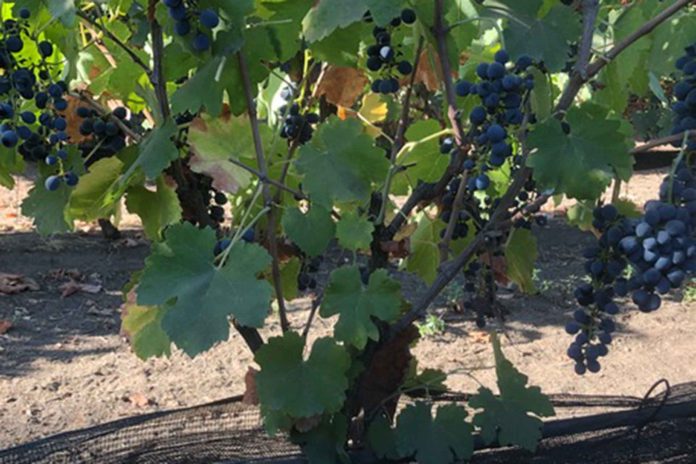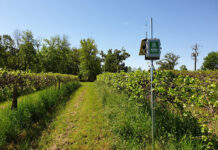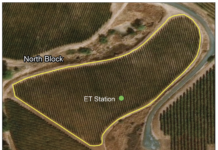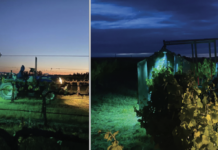We have a small vineyard consisting of mostly French and a few Spanish varietals planted on deep sand, sandy loam, and river rock clay soils. The deep sand soil creates vines that are balanced in growth and grapes that produce wines with a mineral touch. In contrast, the sandy loam soil creates vines that are overgrown with grapes that are excellent as long as the vine growth is controlled in order to keep the vines balanced. The vines were planted in the river rock clay area a few years ago.
The area where the vineyard is planted is a micro-climate within Region 4 (warm growing area) with fall wine grape ripening season in the 90’s during the day and 50’s at night, excellent for slow and balanced ripening.
Since I take care of all vineyard and cellar requirements, I am always looking for designs and procedures that decrease time, work, and number of steps for completion. Everything is consciously engineered and tested for simplicity, repeatable results, and ease of care.
VSP
When the vines were first planted in 2007, I naturally assumed that Vertical Shoot Projection (VSP) was “the” way to trellis the vines because of its popularity and my ignorance of trellising designs. Because the rows are oriented east-west for esthetic reasons, special considerations were required for sun protection on the south side of the vines.
I discovered that it was very difficult to get grapes of full physiological maturity balanced with the right brix to make premium wines, so I began looking at the trellis design wondering if there was a better way to achieve my goal of premium grapes without the extensive leaf and cane thinning and hedging. As I looked more intently at the VSP design, I decided there was a better way to trellis the grapes for this area; one that enabled easier vine maintenance without multiplying issues, like the ever-prominent powdery mildew.
With the VSP trellis, I had to grow the southside of the vine canes longer to protect the fruit from premature raisining because of the intense sunlight; but that created a perfect environment for powdery mildew because of the “umbrella-like” structure that resulted. Essentially, when the vines were watered by the drip irrigation, the moisture turned to humidity that rose up and hung in the fruiting area encouraging mildew growth while the multiple layers of canes and leaves prevented the mildew sprays from reaching the fruit. I then pushed the vine canes up to get some airflow in the fruiting zone; but there was still a serious humidity problem in the fruiting area.
After a few seasons, I decided to find a different trellising design that would eliminate the problems that VSP created. I analyzed the issues with VSP and made a list to be addressed by a different design.
The VSP trellis design relies on the canes projecting vertically, but in warm growing environments with intense sunlight, there is a need for shading of the fruit to prevent premature raisining; but the number of canes required for protection also served as an effective protection from the mildew spray reaching the fruiting zone, while also preventing the sun from penetrating the multiple layers of leaves to created color in the grapes. This technique of allowing the canes to flop over on the vine is known in this area as “California Sprawl” and it shades the fruit with many layers of leaves, thus preventing adequate air movement to help prevent powdery mildew. Additionally, having canes over 4 feet long, the green matter of the vines was exceeding the green matter-to-fruit ratio for growing premium quality grapes. The ratios for growing premium quality fruit are generally known to be 15 leaves per bunch and six to eight bunches per vine; but that is for vines grown in a cooler environment, which does not provide adequate protection in Region 4. Consequently, I have been working on creating the appropriate ratios for growing wine grapes in Region 4; but the long canes required to protect the fruit was creating a higher level of pyrazines in my fruit and thus flavors of bell-pepper in my Cabernet wines. Essentially, by protecting the fruit from too much sun with the VSP trellis design, there were additional issues of not enough sun to achieve physiological maturity in the grapes, preventing mildew sprays from reaching the grapes for their protection, and off flavors in the Cabernet wines.
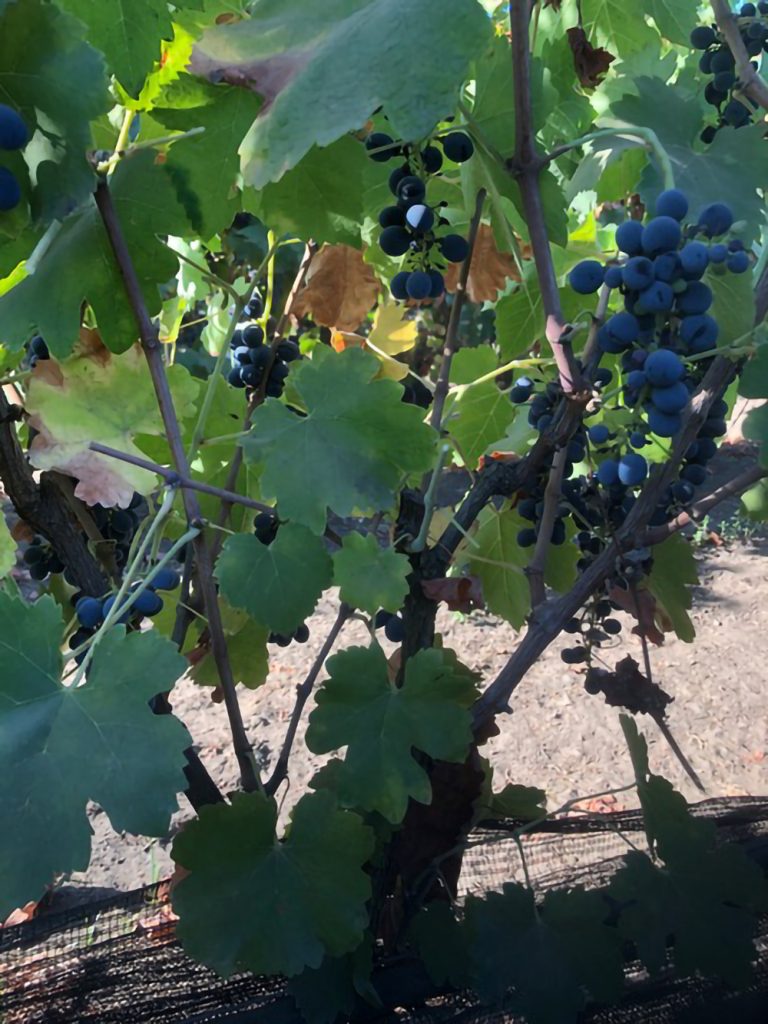
Spur Pruned
Since VSP trellised vines are spur pruned, it was always a fight between what I wanted the vines to do in terms of growth and what the vine actually did. The issue is that the number of buds left on the spur is inversely related to the number of canes that the spur will produce in the spring, especially on mature vines. I pruned to two-buds and would end up with four to six canes from each spur, requiring extensive spring cane and leaf thinning. I then pruned to four-buds which resulted in three to four canes from each spur; and although better, it was still a real issue to get the fruiting zone cleaned up since it was only me doing all the leaf and cane thinning. Interestingly, I take care of a neighboring vineyard that is trellised on the VSP design; and each year, even though it receives leaf and cane thinning, it loses about 15-20 percent of the fruit from powdery mildew.
In my analysis, I noticed the VSP trellis design puts all the fruit in the same area just above the horizontal cordon where all the canes are protruding from and the dead leaves from senescence land and stay, thus covering the fruit. For some vineyards that have adequate and well trained help, these problems might not be an issue; but for a vineyard that has little to no help, I was cleaning all the time. I noted in that having all the fruit in one area, it created problems of cane and fruit entanglement making it harder to harvest the fruit, a higher incidence of bunch-rot, and the dead leaves laying on top of the fruit in the crux of the canes formed at the cordon assisted with additional formation of mildew. I have also found that the fruit from VSP vines had more bird damage because of the readily available canes for perching and eating the grapes.
Nutrition
Concerning the nutrition of the grapes, there is a general theory that states the closer the fruit is to the soil, the better the nutrient supply to the fruit, thus making better fruit for wine. The VSP design puts the fruit a reasonable distance up the trunk away from the nutrient source, which has the potential for decreasing the fruit quality. I have found that the physiological maturity and brix in the fruit harvested from the VSP trellis design is not as balanced as it could be, for some reason.
For example, the fruit I harvested from the vines on my neighbor’s property is on a sandy red clay mix soil and grown on the VSP trellis design. Although the soil has a huge effect on the maturity and quality of the fruit, this vintage’s fruit is very unbalanced with high pH and low Titratable/Total Acid (TA). I also noticed very little sunlight reached the fruit down in the crotch of the cane/cordon, thus creating an issue of physiological maturity, which might have contributed to the acid imbalance.
In summary, the VSP design, at least in our area, produces lower quality and unbalanced fruit, contributes to increased powdery mildew, prevents mildew sprays from reaching the fruit, allows for more bird damage, requires more time and effort to maintain, and requires the soil nutrients to travel farther to the fruit.
New Trellis Design
The goal of a new trellis design became one that allows more light and air into the vine while still protecting the grapes from sunburn and being easy to care for on a small scale. I started looking into other trellising systems that might satisfy the requirements by studying publications, like Dr. Smart’s “Sunshine into Wine” and others, to find the right design. The research spanned the world of grape trellising including designs of France, Italy, Australia, and the U.S. As the analysis proceeded, I discovered there really wasn’t a design that satisfied the identified requirements while still being easy to maintain.
Consequently, I decided to create my own design that would answer my requirements and be easily maintained. The design is essentially a “V” shape with cordons angled up sharply and is named “Shoemaker’s Angled Shoot Projection” (SASP).
SASP
The SASP trellis design has resulted in less maintenance while providing higher quality fruit, significantly less powdery mildew, less bird damage, and easier harvests.
Specifically, the SASP trellis design provides two to four leaves between the sun and fruit, thus providing the correct amount of sunlight on the grapes to achieve the 20 percent flecking recommended by Dr. Smart while preventing sunburn and premature raisining.
This trellis design allows mildew sprays to easily reach into the vine to the fruit without the need for much leaf movement or an expensive fan-style spray rig, resulting in cleaner fruit at harvest. Even though it is still necessary to spray for powdery mildew, the SASP trellis design has decreased the number of sprays by more than half.
The SASP trellis design allows the person harvesting to easily see the fruit for a faster harvest without expensive preparatory leaf cane and leaf thinning. (See above photo.)
In Figure 2, the bird netting can be seen rolled along the drip line; but there are years that I don’t get all the nets up to protect from the birds. The SASP trellis design produces fruit along the angled cordon canes hanging free and making it almost impossible for birds get to the fruit.
As an added benefit, the SASP trellis design has allowed for ‘interplanting’ of additional vines because the angled shoots extend upward and thus require less horizontal space along the support wires. Originally, the vineyard was planted with vines 5 feet apart, now because of the SASP design, I have been able to interplant vines at 2.5 feet apart which has doubled the number of vines while each one is mining the soil for its own nutrients resulting in high quality fruit on each vine.
Interestingly, the vines planted in the fertile sandy loam soil were largely overgrown creating even more of a powdery mildew problem; but now, at the closer spacing, the vines are competing with each other and the amount of green matter growth has decreased resulting in more balanced vines between the leaves and fruit weight.
In Conclusion
The SASP trellis system was created to answer identified issues in our vineyard by mixing design parameters to satisfy the requirements in one trellis design structure. SASP has resulted in more balanced vines with higher quality fruit and easier and less expensive maintenance.
Anyone is considering the SASP trellis design, the individual vineyard’s terroir, requirements, and issues should be considered prior to making the decision to use this design.
Steve Shoemaker is a former Counter-Terrorism expert who started his vineyard to help with PTSD as a result of the 7 years in warzones. He is a current student in the UC Davis Post Graduate Winemakers Certificate Program; and has about two years left to complete his PhD in Counter-Terrorism. However, his happy places are the vineyard and cellar; but sharing his art with others in the greater Clovis, California area is the most fun. He can be reached at: 3oaksvineyardclovis@gmail.com.











